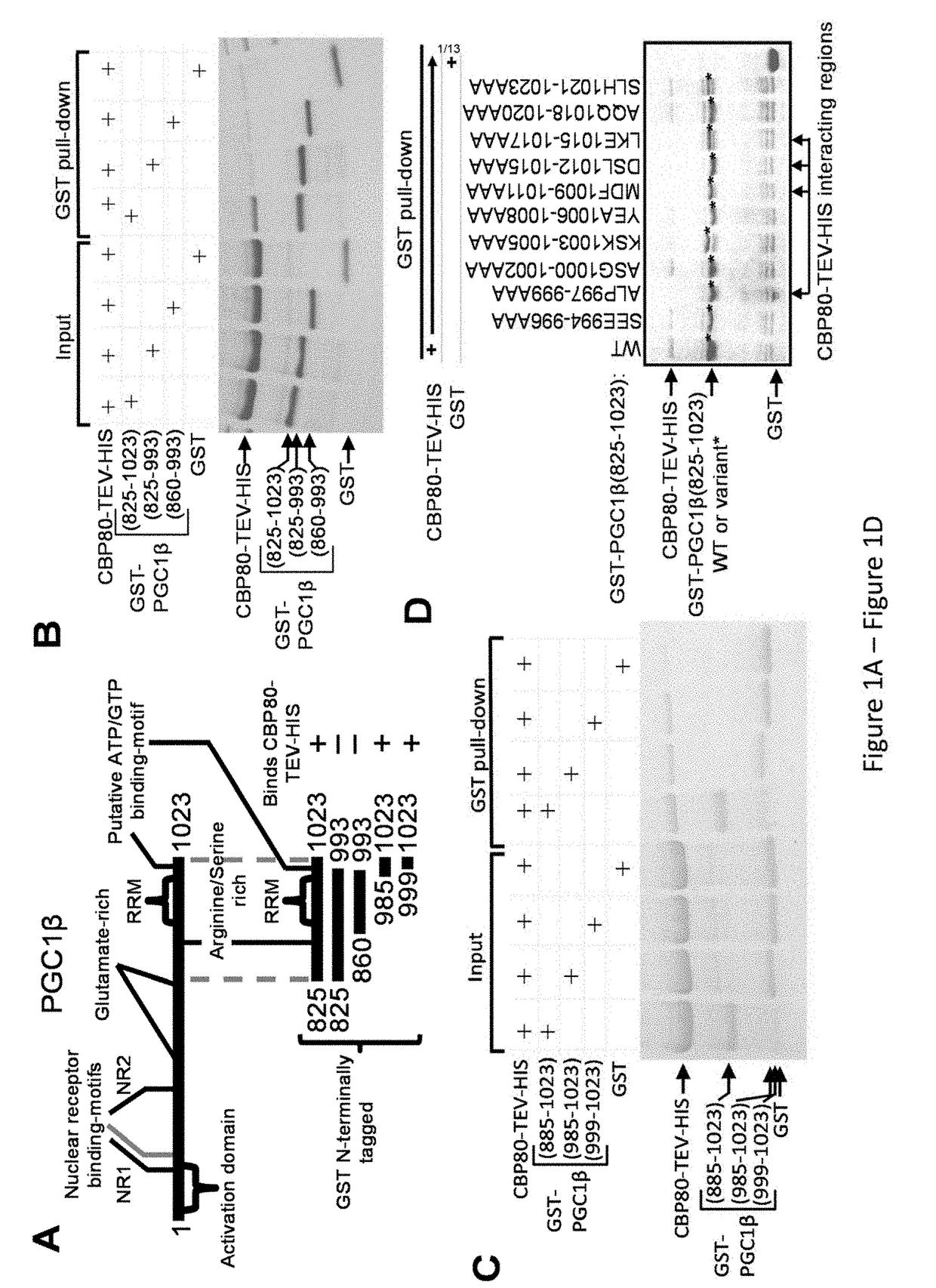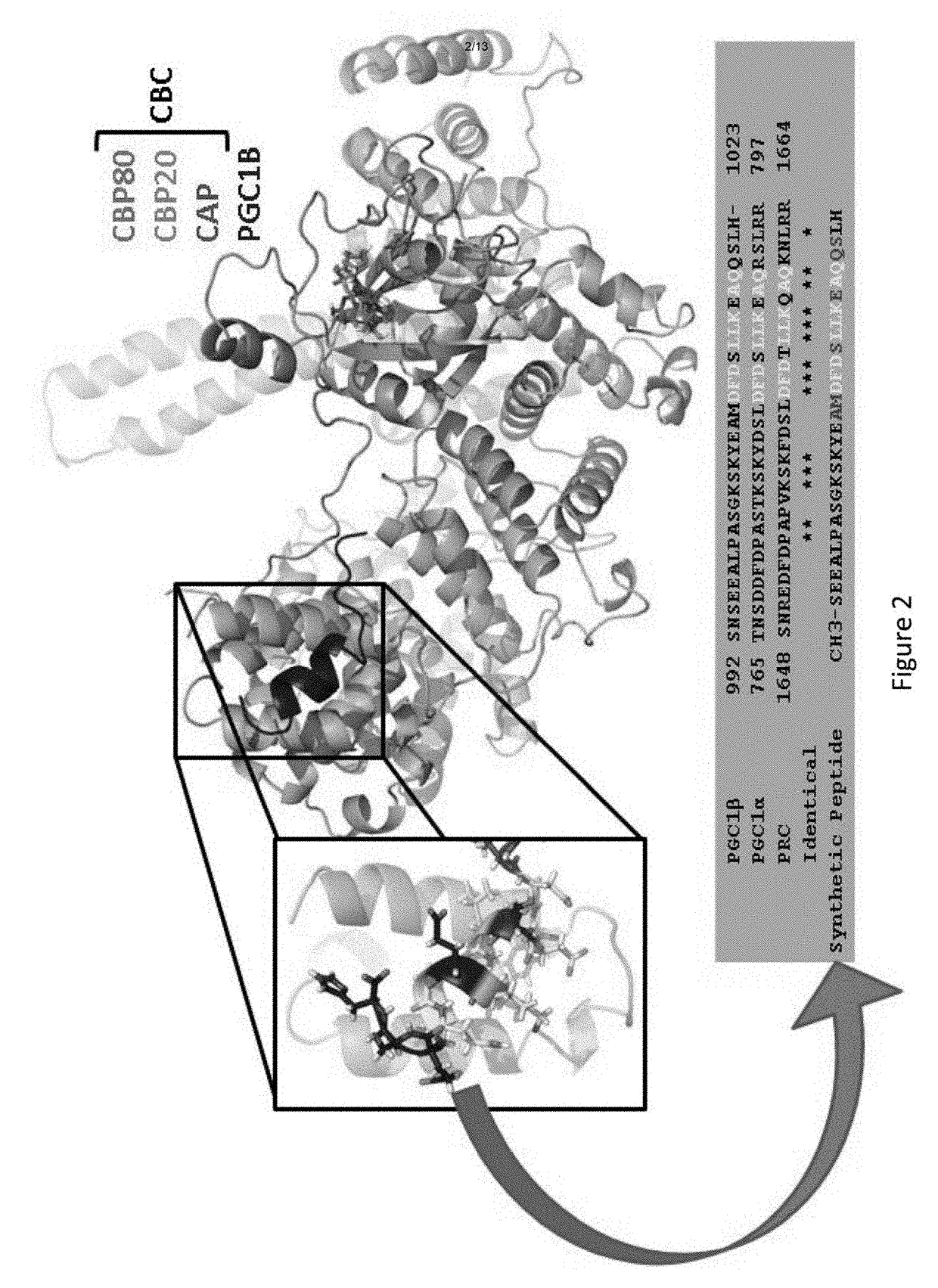Compositions and Methods for Inhibiting CBP80 Binding to PGC1 Family of Co-Activators
a technology of co-activators and compounds, which is applied in the direction of peptides, drug compositions, peptides, etc., can solve the problems of increased uterine cancer, high mortality risk, and increased bone fractures in post-menopausal patients,
- Summary
- Abstract
- Description
- Claims
- Application Information
AI Technical Summary
Benefits of technology
Problems solved by technology
Method used
Image
Examples
experimental examples
[0285]The invention is further described in detail by reference to the following experimental examples. These examples are provided for purposes of illustration only, and are not intended to be limiting unless otherwise specified. Thus, the invention should in no way be construed as being limited to the following examples, but rather, should be construed to encompass any and all variations which become evident as a result of the teaching provided herein.
[0286]Without further description, it is believed that one of ordinary skill in the art can, using the preceding description and the following illustrative examples, make and utilize the compounds of the present invention and practice the claimed methods. The following working examples therefore, are not to be construed as limiting in any way the remainder of the disclosure.
example 1
C-Terminus Binds CBP80 In Vitro
[0287]Yeast-2 hybrid results (Kataoka et al., 1995, Nucleic Acids Res 23:3638) indicated that CBP80 interacts with PGC1β C-terminal to its glutamate rich region (FIG. 1A). Using GST pull-downs of GST-fused PGC1β protein regions and mutated variants thereof, it was observed that: the interaction with CBP80-HIS (baculovirus-produced) is precluded when C-terminal amino acids 994-1023 are absent, 994-1023 fused to GST bind CBP80 alone, and CBP80-HIS interacts with GST-PGC1β amino acid regions 998-999 and 1009-1017 (FIGS. 1B-D). These interacting regions are C-terminal to the RRM and together form a predicted C-terminal α-helix with an ATP / GTP-binding loop region that connects to the RNA-recognition motif (RRM); since PGC1β functions in mitochondrial respiration, this suggests that an ATP-sensing allosteric regulator might control the association of RNA and / or CBP80 with PGC1β.
example 2
olution X-Ray Crystal Structure of CBP80-CBP20 (CBC) Bound to the Helix of PGC1β Via CBP80
[0288]Experiments were conducted to collect X-ray diffraction data from a very large (900 μm long) crystal of the PGC1β-CBC-cap complex and, using prior CBC and CBC-cap structures, (Calero et al., 2002, Nat Struct Biol 9:912; Mazza et al., 2002, EMBO J 21:4458; Mazza et al., 2001, Mol Cell 8:383; Mazza et al., 2002, Acta Crystallogr D Biol Crystallogr 58:2194) have phased through molecular replacement and refined the structure to 0.21 / 0.27 RModel / RFree. By so doing, it was discovered that extra electron density corresponding to an α-helix matched the side-chain residues of the PGC1β C-terminal helix. Notably, the position of the α-helix does not interfere with CBP20 or importin-α (Dias et al., 2009, 16:930; Sato et al., 2009, Genes Dev 23:2537) binding positions on CBP80. CBP80-facing residues of PGC1β are identical in all PGC1 paralogs (FIG. 2), suggesting that the latter may bind CBP80 in a s...
PUM
| Property | Measurement | Unit |
|---|---|---|
| pH | aaaaa | aaaaa |
| pH | aaaaa | aaaaa |
| flow rate | aaaaa | aaaaa |
Abstract
Description
Claims
Application Information
 Login to View More
Login to View More - R&D
- Intellectual Property
- Life Sciences
- Materials
- Tech Scout
- Unparalleled Data Quality
- Higher Quality Content
- 60% Fewer Hallucinations
Browse by: Latest US Patents, China's latest patents, Technical Efficacy Thesaurus, Application Domain, Technology Topic, Popular Technical Reports.
© 2025 PatSnap. All rights reserved.Legal|Privacy policy|Modern Slavery Act Transparency Statement|Sitemap|About US| Contact US: help@patsnap.com



